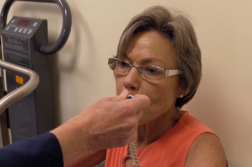BIRMINGHAM, Ala. (Ivanhoe Newswire) — It happens anywhere and anytime … your office, a church, a nightclub, even your child’s school. As horrible as these mass shootings have been, trauma surgeons say people died who didn’t need to. Here’s more on a toolkit surgeons are hoping will save lives.
This is not anatomy class. It’s a course in saving lives.
High school teacher, Christie Morman, says, “We had the opportunity to learn some preventative measures in case anything were to happen in the school.”
Since the Sandy Hook mass shooting in 2012, more than 300 school shootings have followed where …
Some shooting victims bled out and died before first responders got to them. That’s why the American College of Surgeons has launched the ‘Stop the Bleed’ program. It tells anyone what to do in an emergency before first responders can arrive.
Dale Davis, RN, University of Alabama at Birmingham, stated, “If the patient can get to the trauma center alive, we can keep them alive most of the time.”
The ‘Stop the Bleed’ kit has a tourniquet, gauze, gloves and instructions to control bleeding. The American College of Surgeons wants these kits distributed throughout public places, such as arenas, offices and schools, just like AED’s.
Virginia Strickland, MD, University of Alabama at Birmingham, shared, “Just that knowledge is a little bit of power in a situation where you are powerless.”
Morman is trained in using the kit.
Morman says, “Now I feel comfortable and I wouldn’t be as worried or nervous or looking for somebody else to help. I feel like I would be able to actually assess the situation and take care of whatever needed to be done … ”
… to save a life.
The ‘Stop the Bleed’ kits are not only for shooting events, but can also be used in any situation where there’s massive bleeding that needs to be controlled, such as a car accident or large cuts.
Contributors to this news report include: Milvionne Chery, Producer; Roque Correa, Editor and Videographer.
Free weekly e-mail on Medical Breakthroughs from Ivanhoe. To sign up: http://www.ivanhoe.com/ftk
BLEEDING BE GONE!
REPORT #2539
BACKGROUND: The American Association for the Surgery of Trauma is committed to improving the care of the injured patient through education and research, and strives to provide lay persons as well as health care workers with information about injury in the United States and around the world. Injury prevention is an invaluable part of their efforts. In the United States, injury accounts for over 150,000 deaths and over 3 million non-fatal injuries per year. Around the world, injury is responsible for more than 5 million deaths per year. Many millions more are injured. Every year, nearly 1 million children die from injuries. Tens of millions more require hospital care for non-fatal injuries. Many are left with permanent disabilities or brain damage. The most common injuries are traffic injuries, non-fatal drowning (sometimes referred to as near drowning), burns, falls and poisoning. Traffic injuries and drowning are the leading causes of injury-related death. Injury can be prevented and many lives saved by learning more about the causes of injury and implementing appropriate injury prevention strategies. Many of these strategies are well-established, easily available and relatively inexpensive, such as seat belts and helmets.
(Source: http://www.aast.org/trauma-facts and http://www.factsforlifeglobal.org/13/)
RAISING AWARENESS: Stop the Bleed is a national awareness campaign and call to action. It is intended to cultivate grassroots efforts that encourage bystanders to become trained, equipped, and empowered to help in a bleeding emergency before professional help arrives. The American College of Surgeons Committee on Trauma (ACS COT) is leading the effort to save lives by teaching the civilian population to provide vital initial response to stop uncontrolled bleeding in emergency situations. The Stop the Bleed campaign has been successful in its efforts to inform, educate, and empower the more than 300 million citizens of the United States. ACS is educating other medical providers and the community on bleeding control in all 50 U.S. states and almost 40 countries internationally. The campaign has been extremely successful. There are almost 3,000 registered classes and almost 6,000 instructors registered.
(Source: https://www.facs.org/publications/newsletters/cot-news/summer2017/bcon)
TRAINING THE PUBLIC TO STOP THE BLEED: Uncontrolled bleeding is responsible for 35 percent of pre-hospital trauma deaths and 40 percent of deaths within the first 24 hours. Stop the Bleed teaches civilians simple techniques to slow or stop life-threatening bleeding, believing that people already at the scene can help save lives before first responders arrive. It supports training for law enforcement and other non-medical first responders and recommends easy access to bleeding control kits containing tourniquets, gloves and hemostatic gauze. Ideally, the kits would be located in malls, airports, schools and sports centers, which are the same public spaces where automated external defibrillators are currently found. The Southern Minnesota Regional Trauma Advisory Committee (SMRTAC) began training law enforcement in 2015 using the Bleeding Control for the Injured course. The training lasts about 90 minutes and includes a presentation with videos as well as hands-on practice applying a tourniquet and packing gauze in a simulated wound. “We explain where the tourniquet should be placed on the limb and how to route it through and tighten it. Then participants practice on each other or on themselves,” explains Todd M. Emanuel, R.N., trauma performance improvement coordinator at Mayo Clinic’s campus in Rochester, Minnesota. “We also demonstrate how to use gauze to stop bleeding in areas where you can’t use a tourniquet, such as the groin, armpit, and external chest or abdomen and how to maintain the airway in patients with neck wounds.”
* For More Information, Contact:
Virginia Strickland, MD Bob Shepherd, Media Relations



